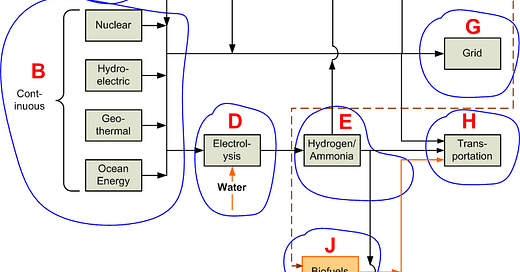The Solar Section of the Energy Grid
The above sketch is based on the grid shown in the post An Energy Framework. Solar power is located in Section A of the grid. The electricity generated from solar is either used directly (Section G on in the sketch), or it can be stored for future use (Section C).
Solar power is very intermittent in nature. After all, it is nighttime half the time, and the sun does not always shine during the day. Therefore, the future of solar as an alternative energy source relies heavily on the ability to store the energy that it generates.
The Table below, which is based on the structure presented in An Energy Framework, summarizes the energy properties of solar. It is compared to the properties of diesel fuel.
Table 4.1
Assessment of Alternative Energy Sources
GHG Emissions
Solar has no direct greenhouse gas emissions. This is why it is so important in a decarbonized future. However, vast amounts of fossil fuels will be needed to build and operate the solar farms needed to replace those fossil fuels.
Renewable
Solar is renewable ― at least on a human time scale. It will be billions of years before sun stops shining.
Energy Dense
Solar energy is not dense ― large amounts of land are needed. for the solar panels to generate the amount of energy that we currently obtain from the fossil fuels.
Available
Solar energy is only available half the time (during daylight hours). Even during the day the sun may not be shining.
Dispatchable
Solar power cannot be rapidly cranked up and down in response to short-term changes in demand. It is not dispatchable.
Keep reading with a 7-day free trial
Subscribe to Net Zero by 2050 to keep reading this post and get 7 days of free access to the full post archives.






